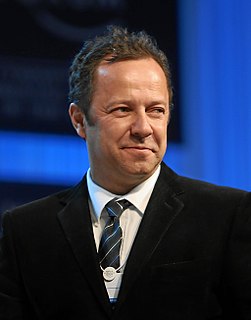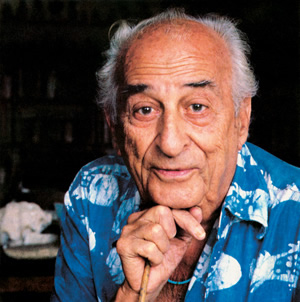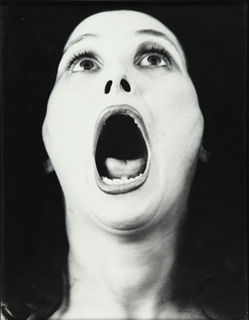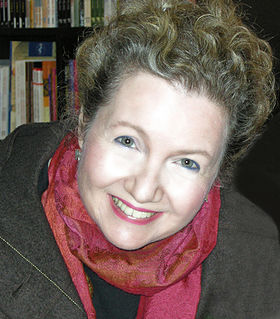
The São Paulo Museum of Art is an art museum located on Paulista Avenue in the city of São Paulo, Brazil. It is well known for its headquarters, a 1968 concrete and glass structure designed by Lina Bo Bardi, whose main body is supported by two lateral beams over a 74 metres (243 ft) freestanding space, considered a landmark of the city and a main symbol of modern Brazilian architecture.

The São Paulo Art Biennial was founded in 1951 and has been held every two years since. It is the second oldest art biennial in the world after the Venice Biennale, which serves as its role model.

Vik Muniz is a Brazilian artist and photographer. Initially a sculptor, Muniz grew interested with the photographic representations of his work, eventually focusing completely on photography. Primarily working with unconventional materials such as tomato sauce, diamonds, magazine clippings, chocolate syrup, dust, dirt, etc., Muniz creates works of art, referencing old master's paintings and celebrity portraits, among other things, and then photographs them. His work has been met with both commercial success and critical acclaim, and has been exhibited worldwide. He is currently represented by Galeria Nara Roesler based in New York and Brazil.

Héctor Julio Páride Bernabó or Carybé was an Argentine-Brazilian painter, engraver, draughtsman, illustrator, potter, sculptor, mural painter, researcher, historian and journalist. He settled in Brazil and naturalized as a Brazilian.

The creation of art in the geographic area now known as Brazil begins with the earliest records of its human habitation. The original inhabitants of the land, pre-Columbian Indigenous or Natives peoples, produced various forms of art; specific cultures like the Marajoara left sophisticated painted pottery. This area was colonized by Portugal in the 16th century and given the modern name of Brazil. Brazilian art is most commonly used as an umbrella term for art created in this region post Portuguese colonization.

Hélio Oiticica was a Brazilian visual artist, sculptor, painter, performance artist, and theorist, best known for his participation in the Neo-Concrete Movement, for his innovative use of color, and for what he later termed "environmental art", which included Parangolés and Penetrables, like the famous Tropicália. Oiticica was also a filmmaker and writer.

Gretta Alegre Sarfaty also known as Gretta Grzywacz and Greta Sarfaty Marchant, is a painter, photographer and multimedia artist who earned international acclaim in the 1970s, from her artistic works related to Body art and Feminism. Born in Greece, she moved with her family to São Paulo in 1954. From 1976 she lives and works in London, São Paulo and New York. Alongside her art she was the founder of the project-led space, Sartorial Contemporary Art (2005–2010) and since 2010 has been running a family trust the Alegre Sarfaty Collection.

The Museum of Contemporary Art, University of São Paulo is a contemporary art museum located in the main campus of the University of São Paulo, in São Paulo, Brazil, and in Ibirapuera Park, in the same city. It is one of the largest art museums in the country.
Fabiana de Barros is a Swiss artist of Brazilian origin. She is the daughter of a well-known Brazilian photographer and contemporary artist, Geraldo de Barros, and is also the sister of the artist Lenora de Barros. She works and lives in Geneva and São Paulo.
Beto Shwafaty is a Brazilian conceptual artist, visual researcher and critic.
Lucas Simes is a Brazilian artist based in São Paulo.

Sheila Leirner is a French Brazilian curator, journalist, and art critic, as well as a writer. She was chief curator of the XVIII and XIX São Paulo Art Biennials.
Rosângela Rennó Gomes is a Brazilian artist who lives and works in Rio de Janeiro. Her work consists of photographic images from public and private archives that question the nature of an image and its symbolic value. With the use of photographs, installations and objects, she appropriates and sheds new light on an anonymous body of photographs and negatives found mostly in flea markets, family albums, newspapers and archives. Rennó's interest in discarded images and habit of collecting were decisive in establishing her work strategies.

Willys de Castro was a Brazilian visual artist, poet, graphic designer, industrial designer, stage designer and magazine editor. De Castro is best known for his "Active object" series and is considered to be a pioneer and founding contributor of the Neo-Concrete Movement.
Waldemar Cordeiro was an Italian-born Brazilian art critic and artist. He worked as a computer artist in the early days of computer art and was a pioneer of the concrete art movement in Latin America.
Hércules Rubens Barsotti was a Brazilian painter, graphic designer, scenographer and costume designer. He was a member of the Neo-Concrete Movement.
Geraldo de Barros was a Brazilian painter and photographer who also worked in engraving, graphic arts, and industrial design. He was a leader of the concrete art movement in Brazil, co-founding Grupo Ruptura and was known for his trailblazing work in experimental abstract photography and modernism. According to The Guardian, De Barros was "one of the most influential Brazilian artists of the 20th century." De Barros is best known for his Fotoformas (1946-1952), a series of photographs that used multiple exposures, rotated images, and abstracted forms to capture a phenomenological experience of Brazil's exponential urbanization in the mid-twentieth century.

Hildegard Baum Rosenthal was a Swiss-born Brazilian photographer, the first woman photojournalist in Brazil. She was part of the generation of European photographers who emigrated during World War II and, acting in the local press, contributed to the photographic aesthetic renovation of Brazilian newspapers.
Sheila Maureen Bisilliat is an English-born Brazilian photographer.
Carla Zaccagnini is a Brazilian artist and curator.












